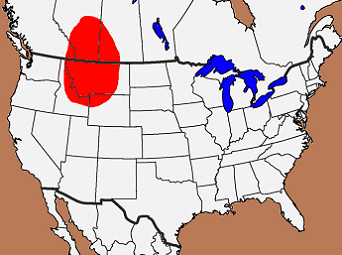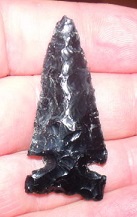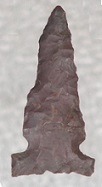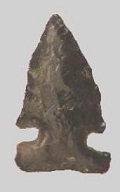Outline is Representative of Size and Shape:

Name Details:
Identified By: Earl H. Swanson and Alan L. Bryant
Named For:
Date Identified: 1964
Type Site: Birch Creek Valley, Idaho
Comment: Ruth Gruhn (1961) excavated Wilson Butte Cave in southwestern Idaho which is considered the type site by some. She originally identified these points as Southern Side notch points. They were then re-typed to Bitterroot Side Notch points.
Identified By: Earl H. Swanson and Alan L. Bryant
Named For:
Date Identified: 1964
Type Site: Birch Creek Valley, Idaho
Comment: Ruth Gruhn (1961) excavated Wilson Butte Cave in southwestern Idaho which is considered the type site by some. She originally identified these points as Southern Side notch points. They were then re-typed to Bitterroot Side Notch points.
Point Validity:
Valid type
Swanson was a highly respected anthropologist from Idaho. Bryant is an anthropologist who has written many influential publications. This type was named in a professional publication and has many professional references. This type is considered a valid type. This type is problematic in that it has overlapping characteristics with two other types (see additional comments). However, the key distinguishing characteristics between the types is the distribution of the difference types. Even if the three types are the same, they are professionally seen as separate types and therefore they are still considered valid types.
Swanson was a highly respected anthropologist from Idaho. Bryant is an anthropologist who has written many influential publications. This type was named in a professional publication and has many professional references. This type is considered a valid type. This type is problematic in that it has overlapping characteristics with two other types (see additional comments). However, the key distinguishing characteristics between the types is the distribution of the difference types. Even if the three types are the same, they are professionally seen as separate types and therefore they are still considered valid types.
Bitterroot Side Notch
AKA: Southern Side Notch (Gruhn, 1961)Cluster: Northern Side Notch Cluster
Description of Physical Characteristics and Flaking Pattern:
This is a medium triangular side notch point with an elliptical cross section. The blade ranges from slightly excurvate to straight. Parallel to diagonal notches are generally narrow and may vary from shallow to deep with deep notch being the most common. The shoulders are horizontal with an expanded stem. The basal edges generally contract towards the base with rounded basal corners. The base is generally straight, but may vary from slightly concave to slightly convex. This point has a random flaking pattern.
Size Measurements:
Total Length - 28 to 114 mm (average 40 to 60 mm), Stem Length - 11 to 16 mm, Blade Width - 16 to 34 mm, Neck Width - 10 to 17 mm, Stem Width - 14 to 33 mm, Thickness - 4 to 8 mm
Total Length - 28 to 114 mm (average 40 to 60 mm), Stem Length - 11 to 16 mm, Blade Width - 16 to 34 mm, Neck Width - 10 to 17 mm, Stem Width - 14 to 33 mm, Thickness - 4 to 8 mm
Commonly Utilized Material:
The most commonly used material is obsidian followed by chalcedony, rhyolite, and ,local and exotic cherts
The most commonly used material is obsidian followed by chalcedony, rhyolite, and ,local and exotic cherts
Additional Comments:
This point shares the same characteristics as the Northern Side Notch and the Cold Springs Side Notch (in the Northwest) with all three having overlapping attributes. Homer (1980), argues that these three types are confusing and have inconstant application. Many differentiate the three types based on region with the Cold Springs found on the Columbia Plateau, the Bitterroot on the Northern Plains and into the Northern Great Basin.
Homer (1980) did a battery of measurements on the three types and found that there were no significant distinguishing characteristics between the three types.
This point shares the same characteristics as the Northern Side Notch and the Cold Springs Side Notch (in the Northwest) with all three having overlapping attributes. Homer (1980), argues that these three types are confusing and have inconstant application. Many differentiate the three types based on region with the Cold Springs found on the Columbia Plateau, the Bitterroot on the Northern Plains and into the Northern Great Basin.
Homer (1980) did a battery of measurements on the three types and found that there were no significant distinguishing characteristics between the three types.
Distribution:

Distribution Comments:
This point is primarily found in northern Idaho, northwestern Wyoming, western Montana, and into southern Alberta, southeastern British Columbia, and southern Saskatchewan. These point may extend into the Dakotas, but more research is needed to place the distribution there.
This point is primarily found in northern Idaho, northwestern Wyoming, western Montana, and into southern Alberta, southeastern British Columbia, and southern Saskatchewan. These point may extend into the Dakotas, but more research is needed to place the distribution there.
Age / Periods:
Date: 7,500 - 6,500 B.P.
Cultural Period: Early to Middle Archaic
Glacial Period: Middle Holocene
Culture:
Date: 7,500 - 6,500 B.P.
Cultural Period: Early to Middle Archaic
Glacial Period: Middle Holocene
Culture:
Age Details:
This type is associated with the Bitterroot Phase. Radiocarbon dates of 7,245 +/- 255 and 7,115 +/- 50 at the Stampede site, 6,720 +/- 170 at The Gap site (Peck, no date).
This type is associated with the Bitterroot Phase. Radiocarbon dates of 7,245 +/- 255 and 7,115 +/- 50 at the Stampede site, 6,720 +/- 170 at The Gap site (Peck, no date).
Similar Points:
Archaic Side Notch, Avonlea, Cold Springs, Elko, Irvine, Lewis, Lookingbill, Mallory, Northern
Archaic Side Notch, Avonlea, Cold Springs, Elko, Irvine, Lewis, Lookingbill, Mallory, Northern
Other points in this cluster / Related / Associated Points:
Bitterroot, Blackwater, Calderwood, Cold Springs, Elko Side Notch, Jensen, Maple Leaf, Mummy Cave, Northern Side Notch, Pahaska, Salmon River Fishtail, San Rafael, Sudden Shelter, Ventana Side Notch
Bitterroot, Blackwater, Calderwood, Cold Springs, Elko Side Notch, Jensen, Maple Leaf, Mummy Cave, Northern Side Notch, Pahaska, Salmon River Fishtail, San Rafael, Sudden Shelter, Ventana Side Notch



